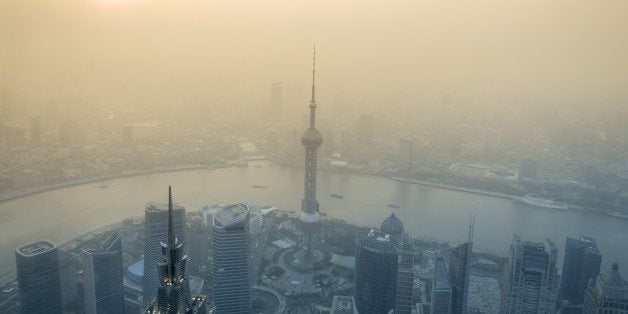
In recent years, many approaches to framing climate change have been tested on the largely indifferent American public. Some major environmental organizations have tried to call our attention to the spoilage of nature, emphasizing everything from the threat to photogenic polar bears to the loss of coral reefs from acidification of the oceans. Others have highlighted the economy-reviving potential of elusive "green jobs." The Pentagon and intelligence community are now describing climate change as an immediate national security threat. Some commentators have even tried to get Americans to care by pointing out that climate change could mean the end of coffee and red wine. And of course, a growing chorus of scientists have also been trying to let us know that, ahem, it could also mean the end of human civilization.
None of these have really worked: we're still on track to soar past the agreed-upon goal of limiting warming to 2 degrees Celsius over pre-industrial temperatures. (Billionaire climate activist Tom Steyer summed up the situation recently for The New York Times thus: "One side argues morality and polar bears, and the other side argues jobs. You're never going to win with polar bears.")
But there are signs that policy-shapers might finally have hit on a winning way to frame the threat-cum-opportunity posed by the pollution-driven phenomenon of climate change: it is first and foremost an urgent public health crisis.
This message has broken through to the highest levels. Last June, the Obama administration announced its Clean Power Plan, which would reduce carbon emissions from existing power plants. The most significant U.S. policy action to date to limit climate-warming emissions, it was unveiled not at a clean energy start-up, or in a national forest ravaged by beetle kill, or even on the waterfronts of Sandy-battered New Jersey, but at a hospital.
President Obama described the benefits of his plan in his weekly address, recorded in the asthma ward of the Children's National Medical Center in Washington, D.C: "In just the first year that these standards go into effect, up to 100,000 asthma attacks and 2,100 heart attacks will be avoided -- and those numbers will go up from there."
President Obama has made a smart bet, choosing by far the most compelling item on the menu of climate crisis frames: it is a direct threat to your health, and the health of your children. This tactical approach is bolstered both by hard science and by some deep-seated features of human psychology.
First, the hard numbers. The new regulations will require shifts to cleaner-burning technologies and fuels, which will cut down on the amount of dangerous co-emitted pollutants like sulfur dioxide, nitrogen oxides, and particulate matter streaming out of smokestacks. As a result, the EPA estimates that by 2030, the Clean Power Plan would "avoid up to 6,600 premature deaths, up to 150,000 asthma attacks in children, and up to 490,000 missed work or school day." This adds up, according to the EPA, to $93 billion worth in climate and health benefits. (It's worth noting that since its inception in 1970, the Clean Air Act, under which the EPA is now regulating carbon, has been a huge economic success story no matter whom you ask: according to an independent study commissioned by the Small Business Majority in 2010, the ratio of financial benefits to the law's cost was 40 to 1. The EPA's own peer-reviewed study found a ratio of 90 to 1.)
This isn't even taking into account the wide and widening range of present-day health risks linked to global warming fueled by carbon pollution, from vector-borne diseases like malaria and dengue fever to dangerous heat waves and extreme weather events. The children in the asthma ward whose symptoms are exacerbated by today's co-emitted pollutants (such as zone precursor gases and fine soot particulate matter) will, as adults, be much more likely to suffer the consequences of all that carbon dioxide, too: by 2090, a California resident will be up to seven times as likely to die in an extreme heat spell.
But there's also plenty of science suggesting that human just aren't cognitively wired to deal with a seemingly spatially and temporally distant threat like climate change. Conversely, recent research suggests that appealing to immediate health risks and benefits speaks much more urgently to our primal fears and hopes. Matthew Nisbet and Edward Maibach published a study in 2012, in the journal Climatic Change Letters, which found that, compared to framing climate change as a national security or an environmental threat, "depicting climate change as an issue of public health was the most likely to generate feelings of hope and the least likely to generate feelings of anger."
"Results show that across audience segments," they wrote, "the public health focus was the most likely to elicit emotional reactions consistent with support for climate change mitigation and adaptation."
Recent events suggest that Obama isn't the only decision-maker to have caught on to the power of this framing. Much ink has been spilled on the recent U.S.-China climate agreement, and the shot in the arm it has provided to global negotiations. But what catalyzed it? For the most part, the driving factor was Chinese citizens' concern about health risks from exposure to "soot storms" created by pollutants emitted by coal burning - and Chinese leaders' concerns about the social unrest those fears might trigger. The power and "tipping point" quality of those fears was demonstrated anew in the past couple weeks, as Under the Dome, a new documentary about the perils of China's air pollution, went viral. The film garnered more than 300 million views in the space of a few days. The authorities cautiously praised it, before abruptly blocking access to it, once they saw how popular its message had become.
And what is likely to move officials in India, the world's third biggest carbon emitter and critical lynchpin in current climate negotiations, toward more ambitious commitments leading up to this year's "last best chance" of a global agreement in Paris? Certainly not a feeling that they're responsible for saving the rest of us from our own fossil fueled-excesses.
During my reporting for my new book about the health and climate impacts of black carbon pollution, I heard this message repeatedly from those active in India's climate policy and science circles. As Anumita Roychowdhury, executive director of the Centre for Science and Environment in New Delhi, pointed out to me, U.S. EPA regulations on particulate matter pollution weren't motivated by climate considerations: "The driver has always been public health, right?" Veerabhadran Ramanathan, a pioneering climate scientist born in India and now at UC San Diego's Scripps Institution of Oceanography, echoed this point to me. "You tell me why in the United States we have air pollution laws," he said when we met in Lucknow, one of India's most polluted cities. "Because of climate? Because of (the) ecosystem? No! The whole western European clean air act is [about] health. I don't think Indians are different."
To date, the dominant framing of climate action, from D.C. to Delhi, has been on the economic hairshirts that must be donned. The commitments made last year in Lima weren't binding largely because the whole process has been perceived as an arms-race in reverse: who wants to be the first to sacrifice their economic growth? But what if the $5 trillion in health benefits (80 percent of them to be realized in Asia) by 2030 resulting from reductions of methane and black carbon figured more largely in climate mitigation discussions, instead? The same case can be made for the immediate health benefits of ramping down carbon dioxide emissions: a recent modeling study of a potential carbon tax in China concluded that "a policy which reduces carbon emissions by 5% every year from our base case will also reduce premature deaths by some 3.5 to 4.5%."
Meanwhile, a study released last month by researchers from the University of Chicago, Yale and Harvard concluded that 660 million Indians lose an average of 3.2 years of life due to exposure to air pollution. As reports like these keep rolling in - reinforcing the anecdotal but unmistakable evidence of the smog that stings their eyes and throats - elites in New Delhi are finding the air quality crisis increasingly difficult to turn away from.
The problem is global in scope: worldwide, household and outdoor air pollution combine to kill over seven million people every year. The latest science shows that the challenge of averting the coming catastrophe of an overheated planet aligns neatly with the fight against the daily catastrophe of this air pollution. Focusing on these concrete benefits might just be a winning message for political leaders and climate hawks alike as the negotiations in Paris approach: "You know that old saying, 'Well at least you have your health'? Well, you may not even have that, unless governments take strong, rapid action to reduce climate-warming pollution."
President Obama seems to get this. There are mixed but somewhat encouraging signs that China's leaders and India's Narendra Modi are awakening to the power of focusing on the immediate health benefits of clearing the skies, as well. All of which is cause for hope in this pivotal year for the global climate.
